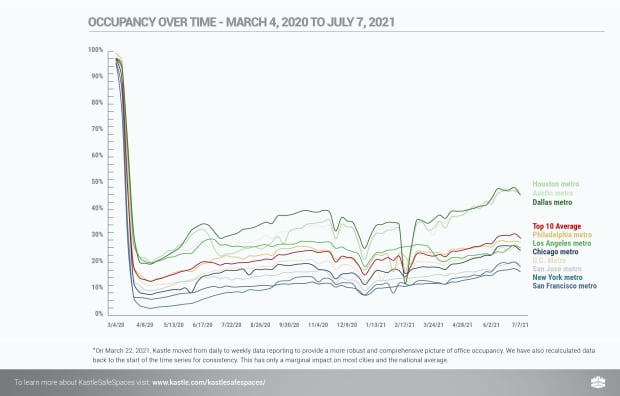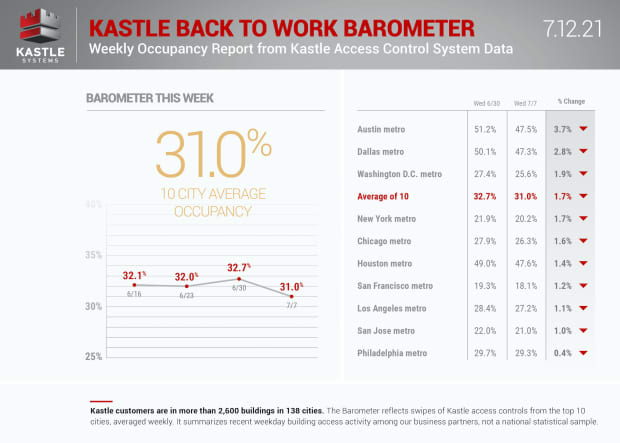This post was originally published on this site
Manhattan neighborhoods that once brimmed with office workers have been eerily quiet for much of the past year and a half, with restaurants that once served the lunch rush now shuttered, and typically crowded sidewalks largely empty.
And while many New Yorkers have eagerly returned to restaurants, bars and movie theaters since receiving the COVID-19 vaccine, they’re in far less of a hurry to return to their former five-day-a-week in-person office schedule (and the corresponding commute). Still, on average around 20% of workers are back at city offices, a major improvement from the depths of the pandemic, according to data from Kastle Systems, a building security firm based in New York.
“What we’re seeing is that only about 7% of companies have concrete ‘return to office plans,’” said Joe Brady, CEO of Americas of the Instant Group, a commercial real estate consulting firm. “We’re hearing quite a bit from the likes of Goldman Sachs
GS,
[which has mandated that a majority of its workers return to the office in person], but by and large, many of the other corporations in tech and other industries are still really uncertain about what ‘return to office’ means.”
Nationwide, more workers are quitting their jobs than at any point in the past two decades, in many cases driven by a reluctance to return to the office after a year of successfully working from home. (More than half of remote workers in the U.S. would consider quitting their jobs if forced to return to the office, according to a recent poll from Fortune.) In New York, municipal workers have openly protested the city’s timeline for returning them to their offices. The spread of the highly contagious Delta COVID-19 variant has become an ominous backdrop to this dynamic, and while cases remain low in New York City, the city’s test positivity rate has recently nearly doubled, from a seven-day average of 0.73% at the end of June to 1.33% this week, according to city data.
(A representative for Mayor Bill de Blasio’s office said that by bringing the city’s workforce back on a staggered schedule beginning in May, the city is sending an important message about how to return workers to offices safely and effectively, and that more broadly, there are positive signs that workers have begun returning to city office buildings.)
“One of the really profound concepts that came out of our research was this idea that if you live in Westchester County and you have to endure an hour-and-a-half commute each way, there has to be a purpose for you to be in the office versus passive attendance,” Brady said. “You’re not going to show up just so your manager can see you’re sitting at your assigned station. There’s this notion that there [needs to be] a specific agenda, specific meetings, a reason for you to endure a long commute.”
Nevertheless, office buildings are seeing a slow but steady return of their workers. According to the most recent Weekly Occupancy Report from Kastle Systems, the New York City offices they work with were at 20.2% occupancy the week of July 7. Occupancy rates in Kastle’s report are determined based on the number of security cardholders swiping into an office building in a given week. The company works with 3,600 buildings with approximately 1.3 million cardholders in 138 cities nationwide, and 274 buildings with approximately 75,000 cardholders in New York City.
While occupancy rates in city office buildings were at 98.8% in mid-February, by mid-April, they’d plunged to a low of 4.3%. The most recent week saw a slight dip in occupancy, likely attributable to the Fourth of July holiday, but overall, occupancy numbers have been incrementally increasing since COVID-19 vaccines first became available this spring. (In mid-April of this year, office occupancy rates hovered around 15%.)

Kastle Systems
“It’s been steadily growing,” said Kastle Systems chairman Mark Ein. “If you really think about the fact that the first vaccinations widely available for people under 65 were in mid-April and mid-May, that’s when we started to see the numbers tick up.”
But with summer holidays, “It has plateaued a little,” Ein said. “We’ve had a big step-up since the beginning of the year, but now it’s kind of leveled off, and I think it will stay that way through the summer and the next big surge will be after Labor Day [Sept. 6].”
New York’s offices are still relatively empty compared with those in nearly every major U.S. city other than San Francisco, where the most recent weekly occupancy rate was 18.1%. By comparison, Houston, Dallas and Austin all had office occupancy rates upward of 47% the week of July 7, according to Kastle’s data, while in Washington, D.C. occupancy was at 25.6%; in Chicago, occupancy was at 26.3%; and in Los Angeles, occupancy was at 27.2%.

Kastle Systems
“New York has consistently been at the low end of the market, for really two reasons,” Ein said. “It was hit so hard at the beginning, and that had a profound and lasting impact. And markets where people get to the office in their cars have had higher occupancy rates than areas with more mass transportation.”
The slow return of workers to the city’s commercial hubs has become an ongoing source of economic strain for the businesses that have traditionally served throngs of white collar office workers, and in an emailed statement, New York City Hospitality Alliance executive director Andrew Rigie called the issue “a real concern for restaurants and other small businesses in commercial districts that rely on their foot traffic and patronage.”
Also see: As NYC restaurants stretch out, food-cart vendors ask: ‘Where’s our COVID relief?’
Whether the current dynamic changes significantly after Labor Day remains to be seen.
“Everyone is still reeling,” Brady said. “They’ve been working probably harder and longer hours than if they had gone into an office every day. Bringing people back is going to require that more purposeful [approach], and is going to put more onus on managers and leaders to engage in almost more of a hospitality approach.”
Still, signs of the city’s pre-pandemic office life are unquestionably returning. “Six weeks ago, our colleagues in Midtown Manhattan commuting from the suburbs would have a seat to themselves on the train,” said Brady. “About four weeks ago, they started having to share a seat. Now, people are standing.”

